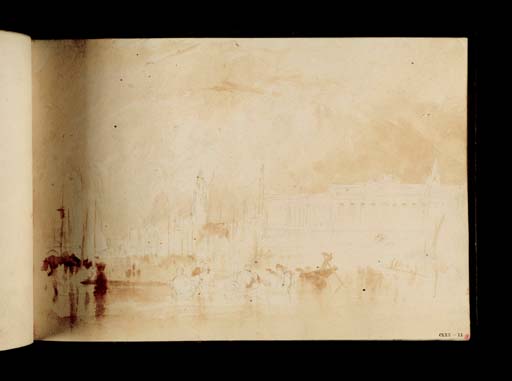Joseph Mallord William Turner The Pool of London, with the Custom House c.1820
Image 1 of 2
Joseph Mallord William Turner,
The Pool of London, with the Custom House
c.1820
Joseph Mallord William Turner 1775–1851
Folio 12 Recto:
The Pool of London, with the Custom House circa 1820
D13826
Turner Bequest CLXX 11
Turner Bequest CLXX 11
Pencil and watercolour on off-white wove paper, 177 x 256 mm
Inscribed in red ink by John Ruskin ‘11’ bottom right
Stamped in black ‘CLXX – 11’ bottom right
Inscribed in red ink by John Ruskin ‘11’ bottom right
Stamped in black ‘CLXX – 11’ bottom right
Accepted by the nation as part of the Turner Bequest 1856
References
1909
A.J. Finberg, A Complete Inventory of the Drawings of the Turner Bequest, London 1909, vol.I, p.493, CLXX 11, as ‘On the Canale di S. Marco, Venice. Sepia.’.
1974
Martin Butlin, Andrew Wilton and John Gage, Turner 1775–1851, exhibition catalogue, Royal Academy, London 1974, p.85 under cat.203.
This sketch, along with folio 11 (D13825; CLXX 10) and a sketch in the Tabley sketchbook No.3, (Tate D07041; Turner Bequest CV41a) formed the basis of a watercolour and subsequent engraving called The Custom House, London Bridge, circa 1825 (Vancouver Art Gallery).1 The point from which this sketch was made from a boat or wharf to the south-east of the Custom House is almost the same as the watercolour, although in that picture the building is seen from a more oblique angle as in folio 11. Various landmarks are visible in the sketch including Christopher Wren’s steeple of St Dunstan-in-the-East above the Custom House at the right, with Monument to the Great Fire of London behind the left corner of the building, and the steeple of St Magnus-the-Martyr and the dome of St Paul’s Cathedral to the left. At the very left of the sketch can be seen a few arches of London Bridge. These features are all retained in the watercolour, although the relative positions of St Paul’s and St Magnus are reversed, reflecting the change of viewpoint.
As in the sketch, the watercolour contains substantial shipping, and the figure of a lighterman drawn in brown wash steering a boat with a paddle is adopted, though in a different pose, in the painting.2 Figures in boats faintly drawn in pencil in the centre foreground of the sketch may have influenced the two figures pulling in or laying a heavy cable in the Custom House watercolour. There are also similar figures faintly sketched in the foreground of folio 43 (D13858; CLXX 42).
This study is made in a combination of pencil and brown watercolour wash. Turner has washed in the sky and water with clouds and reflections carefully left blank or sponged off. Pencil was used for the outlines of buildings and figures and for architectural details. Turner also used less diluted brown watercolour for boats and other details.
For further information see folio 11.
Verso:
Blank
Thomas Ardill
August 2009
How to cite
Thomas Ardill, ‘The Pool of London, with the Custom House c.1820 by Joseph Mallord William Turner’, catalogue entry, August 2009, in David Blayney Brown (ed.), J.M.W. Turner: Sketchbooks, Drawings and Watercolours, Tate Research Publication, December 2012, https://www


